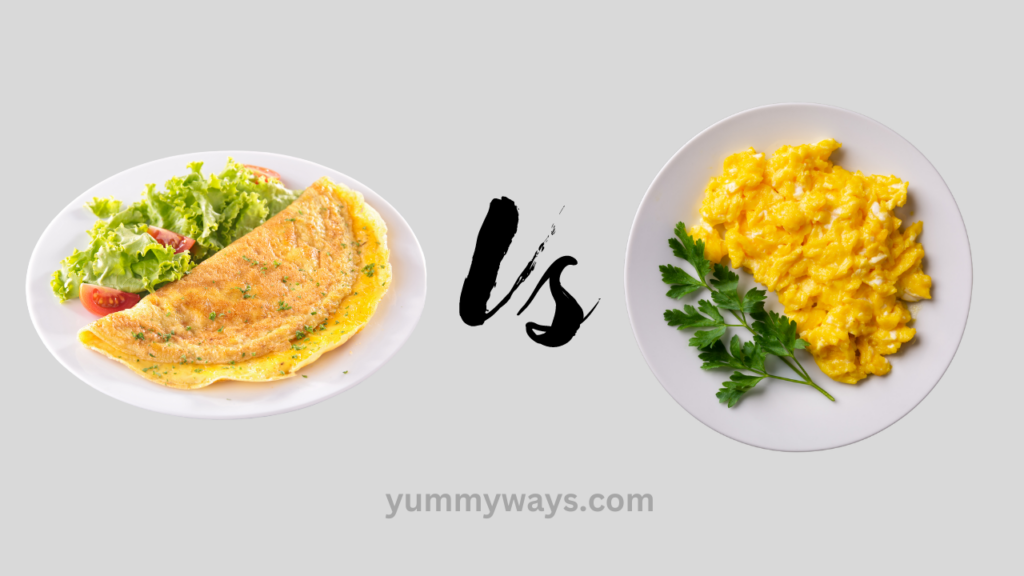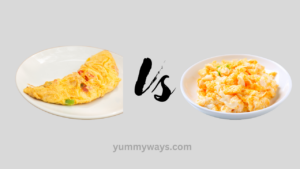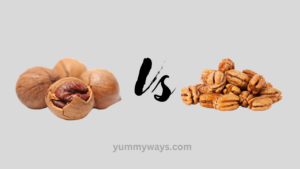Omelets and scrambled eggs are both delicious breakfast options with differences in preparation and consistency. Breakfast is often considered the most important meal of the day, and it’s no wonder with delightful options like omelets and scrambled eggs.

Also Read: Continental Breakfast vs Hot Breakfast: Discover the Ultimate Morning Delight
Contents
Omelet Vs Scrambled Eggs
These two popular dishes offer a satisfying start to the morning, but they vary in terms of preparation and texture. Whether you prefer the light and fluffy nature of an omelet or the creamy and loose texture of scrambled eggs, understanding the key distinctions can help you make the perfect choice for your breakfast cravings.
We will explore the characteristics of omelets and scrambled eggs, and highlight the factors that set them apart. So, let’s dive in and discover the subtle nuances of these two egg-cellent breakfast dishes!
Taste And Texture
When it comes to breakfast choices, omelets, and scrambled eggs are classic options loved by many. Each has its unique appeal, especially when it comes to taste and texture. Understanding the differences in flavor and mouthfeel can help you decide which one is best suited to your preferences.
Flavor Profile
Omelets are known for encapsulating a variety of fillings within the egg mixture, resulting in a harmonious blend of flavors. Whether it’s cheese, vegetables, meats, or herbs, the fillings add depth and richness to the omelet, creating a savory explosion in every bite. On the other hand, scrambled eggs typically have a milder flavor as the eggs are beaten and cooked without the additional ingredients. The simplicity of scrambled eggs allows the natural taste of the eggs to shine through, making it a pure and comforting dish.
Also Read: Fried Egg vs Scrambled Egg: Exploring the Benefits o
Textural Differences
When it comes to texture, omelets tend to have a more substantial mouthfeel due to the presence of fillings. The combination of fluffy eggs and various ingredients creates a satisfying contrast in textures, imparting a delightful chewiness or crunchiness depending on the fillings used. In contrast, scrambled eggs have a uniform and creamy consistency, providing a smooth and velvety sensation on the palate. The simplicity of scrambled eggs allows the focus to be solely on their delicate and custard-like texture.
Nutritional Value
When it comes to nutritional value, both omelets and scrambled eggs are excellent sources of protein and other essential nutrients. However, there are slight differences that might influence your choice depending on your dietary goals. Let’s take a closer look at the nutritional value of these two popular egg dishes.
Protein Content:
Protein is an essential macronutrient that aids in muscle growth, repair, and overall body functioning. Both omelets and scrambled eggs are high in protein, making them an ideal choice for those looking to increase their protein intake. A 100-gram serving of omelet contains approximately 13 grams of protein, while the same serving of scrambled eggs provides around 10 grams of protein. Therefore, if you’re specifically looking to maximize your protein consumption, omelets may be the better option.
Calorie Comparison:
When it comes to calories, omelets and scrambled eggs are relatively comparable. A 100-gram serving of omelet typically contains around 154 calories, while the same amount of scrambled eggs provides approximately 143 calories. This minor difference in calorie content between the two dishes shouldn’t be a significant concern unless you’re strictly adhering to a low-calorie or specific dietary plan.
While both omelets and scrambled eggs offer a good amount of protein, the slight variation in protein content may be a deciding factor for some individuals.
Ultimately, whether you choose omelets or scrambled eggs, you’ll be receiving a nutritious breakfast option that is both delicious and satisfying. Feel free to experiment with different ingredients and cooking techniques to create a personalized dish that meets your taste preferences and nutritional needs.
Also Read: Goose Egg Vs Chicken Egg: Ultimate Showdown!
Preparation Method
In the world of breakfast options, omelets and scrambled eggs are popular choices. While omelets are prepared by folding beaten eggs around fillings, scrambled eggs are simply cooked by mixing the eggs in a pan. Both methods offer different textures and flavors for a delightful start to your day.
When it comes to omelets and scrambled eggs, the preparation method plays a crucial role in determining the outcome. Both dishes have their unique way of being prepared, resulting in distinct textures and flavors. Let’s explore the preparation methods for each:
Ingredients Used
Before diving into the preparation process, let’s take a look at the ingredients used for omelets and scrambled eggs. While the main ingredient remains the same – eggs, there are a few differences in the additional ingredients that enhance the taste of each dish.
| Omelet | Scrambled Eggs |
|---|---|
| Eggs | Eggs |
| Various toppings such as cheese, vegetables, ham, etc. | Salt, pepper, and sometimes milk or cream |
Also Read: Goose Egg Vs Chicken Egg: Ultimate Showdown!
Cooking Techniques
Now, let’s delve into the cooking techniques for omelets and scrambled eggs:
Omelet
- Crack the eggs into a bowl and whisk them until the yolks and whites are fully combined.
- Heat a non-stick pan over medium heat and add a knob of butter or a drizzle of oil.
- Pour the whisked eggs into the pan and allow them to cook for a minute.
- Add the desired toppings onto one half of the omelet.
- Carefully fold the other half of the omelet over the toppings using a spatula.
- Cook for another minute or until the omelet is set and the toppings are heated through.
- Slide the omelet onto a plate and serve hot.
Scrambled Eggs
- Crack the eggs into a bowl and whisk them until the yolks and whites are fully combined.
- Heat a non-stick pan over low to medium heat and add a knob of butter or a drizzle of oil.
- Pour the whisked eggs into the pan and let them sit for a few seconds.
- Using a spatula, gently stir the eggs in a back-and-forth motion until they start forming soft curds.
- Continue stirring and folding the eggs until they reach your desired level of doneness.
- Season with salt and pepper to taste.
- Remove the pan from the heat and transfer the scrambled eggs to a plate.
Versatility In Recipes
When it comes to breakfast options, omelets, and scrambled eggs are two classic dishes that can be enjoyed in various ways. The versatility in recipes allows for a wide range of flavors, ingredients, and cooking styles, making these egg-based dishes popular choices for any meal of the day. From a variety of dishes to adaptability in cooking styles, omelets and scrambled eggs offer endless possibilities for creating delicious and satisfying meals.
Variety Of Dishes
Omelets and scrambled eggs can be transformed into a plethora of dishes, catering to different tastes and dietary preferences. Whether it’s a simple vegetable omelet, a hearty meat-filled omelet, or a fluffy scrambled egg with cheese, the variety of dishes you can create with these versatile recipes is endless.
Adaptability In Cooking Styles
The adaptability of omelets and scrambled eggs extends to various cooking styles. You can sauté, bake, or even microwave these egg dishes to achieve different textures and flavors. This flexibility allows for easy customization based on personal preferences and time constraints, making them a convenient and versatile option for any occasion.
Also Read: Soybeans vs Edamame: What’s The Difference?
Health Considerations
Cholesterol Levels
Egg yolks contain cholesterol, which affects heart health. Eating whole eggs can raise LDL cholesterol.
Impact On Dietary Restrictions
Individuals with dietary restrictions like low-cholesterol diets may opt for egg whites. Always consult a healthcare provider.
Time And Convenience
Time and Convenience: When choosing between omelets and scrambled eggs, considering the time and convenience factor is crucial.
Quick Preparation
Omelets can be prepared quickly by simply whisking eggs, adding fillings, and cooking everything in a pan.
Scrambled eggs are also fast to make as they involve beating eggs and cooking them in a skillet.
Ease Of Cooking
Omelets require minimal effort as you only need to combine ingredients in a pan and fold the egg mixture.
Scrambled eggs are easy to cook by continuously stirring the eggs until they reach the desired consistency.
Cultural And Regional Influences
When it comes to the culinary world, every dish tells a story, shaped by cultural and regional influences. The debate between omelets and scrambled eggs is not just about taste and texture, but also about how these dishes have evolved and become popular in various parts of the world. Understanding the cultural and regional influences behind these beloved breakfast options adds depth to the appreciation of both dishes.
Popular Choices In Different Cultures
In various cultures, both omelets and scrambled eggs have found their place on the breakfast table. For instance, in the United States, scrambled eggs are a breakfast staple, often accompanied by bacon and toast. Meanwhile, in France, omelets are celebrated for their versatility, with fillings ranging from cheese and herbs to mushrooms and even seafood. In Asian cultures, such as in Japan, tamagoyaki, a rolled sweet omelet, is a popular choice for breakfast or as a side dish.
Historical Significance
The roots of omelets and scrambled eggs can be traced back through history. Omelets have a rich historical significance, with evidence of their existence in ancient Roman cookbooks. They have since been adapted and embraced by cultures across the globe. On the other hand, scrambled eggs have a simpler yet equally fascinating historical background, often associated with farm-style cooking in different regions. The historical significance of these dishes adds a layer of tradition and heritage to their enjoyment today.
Conclusion
Both omelets and scrambled eggs offer versatile and delicious meal options. Each dish has its unique characteristics and can be customized to suit individual preferences. Whether you prefer the folded perfection of an omelet or the creamy texture of scrambled eggs, both options are a wonderful addition to any breakfast or brunch menu.

